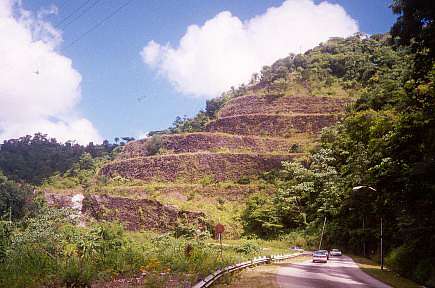
The McClean Monument, October 2000
The Revegetation of the McClean Monument
Victor Quesnel,* T. Frankie Farrell,
Anne Hilton, John Hilton and Luisa Zuniaga
*P.O.Box 47, Port of Spain.

The McClean Monument is the name given by the Botany Group of the Trinidad and Tobago Field Naturalists' Club to the quarry on the Lady Young Road from which material was taken for widening the Churchill-Roosevelt Highway in the years 1976-1979. When the proposal was first put forward for the site to be used as a quarry, there was great public opposition to it, and after months of debate and controversy, permission for the excavation was given by the then Minister of Works, Mr. Hector McClean, hence the name.
Excavation began in May 1976 and was completed in February 1979. Much of the story of those years is told in the Trinidad Naturalist Magazine (Anonymous 1976a, 1976b). The Minister had stated that "benching" would prevent landslips and encourage the natural vegetation to grow back, but the company (Seereeram Brothers Ltd) had also undertaken to replant the area after the excavation was complete. In fact, replanting was never attempted and the revegetation process was left to "Mother Nature". The Botany Group seized the opportunity of studying the recovery, and this article records the changes we have noticed in the past 16 years. At the end of excavation the site consisted of seven terraces getting progressively smaller from bottom to top, and completely bare of vegetation. The rock bed is "micaceous phyllite, a loose, crumbly, material which when wet displays a great tendency to slip" (Anon. 1976a). In the early days of the controversy "the tendency to slip" was perhaps the major concern, and during the excavation minor slips did occur. Even later, after the departure of the excavators, there had been minor slips as is clearly evident in the photograph taken in 1984 (Hilton 1984). It showed that run-off from the terraces did not always follow the planned course. Each terrace is sloped downward towards the base of the next higher terrace and from east to west so that water should run off at the western side of the base of each terrace, except the first, which slopes towards the east. However, it is clear that in some places water has rushed over the edge of one terrace and on to the one below. The interest now lies in the process of revegetation. The Botany Group has visited the site periodically, collecting specimens of the flora and taking photographs. We have concentrated on the first four terraces, numbered from bottom to top. In the following account the names of all species are those given in the Flora of Trinidad and Tobago (Williams et al. 1928- ).
The Observations
January 1984
The site as it was when we first visited it in January 1984 is shown in Hilton (1984). The list of plants we collected is given in Table 1. It will be noticed that there are eight tree species and six shrub species among the 34 species. After less than five years no individual had grown very large nor was any of these 14 species very numerous. It was a little surprising that bois canot (Cecropia peltata) was not more prominent and surprising too that there was no jereton (Didymopanax morototoni ) Both of these trees are usually early colonisers of disturbed land, but with no soil, only rock, the conditions for the growth of trees were extremely unfavourable. Other tree species that were common nearby (bloodwood, Croton gossypiifolius; saltfishwood, Machaerium robinifolium; balsa, Ochroma pyramidale) had begun to invade, but in small numbers only. The species in Table 1. must not be taken as a complete list; there are no sedges and only four grasses. Members of these groups are hard to identify without flowers and we collected only what was in flower. Most of the herbs are common weeds such as Bidens pilosa, Mimosa pudica and Sida urens. On this first visit we saw two or three ground orchids but did not collect them. We preferred to enjoy their beauty and and leave them in place until our next visit.
Table 1. Plants found on the first three terraces in
January 1984
H=herb, SS=sub-shrub, S=shrub, T=tree, V=vine
| Family | Species | Habit |
| Polypodiaceae (ferns) | Petrogramma colomelanos | h |
| Pteris vittata | h | |
| Nephrolepis multiflora | h | |
| Malvaceae | Sida urens | ss |
| Bombacaceae | Ochroma pyramidale | t |
| Eleocarpaceae (Tiliaceae) | Muntingia calibura | t |
| Leguminosae | Centrosema pubescens | v |